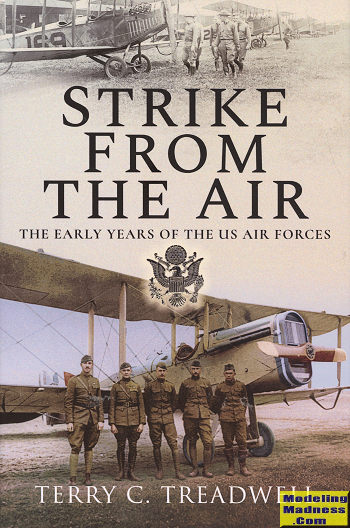 The
United States was one not one of the first to really take advantage of the
aircraft in military service. It was the French, Italians, Germans and British
who put a lot of effort into military aviation. This paid dividends when Europe
went to war in 1914. At that time, the US was still putting minimal effort into
aviation and had little more than training aircraft in service.
The
United States was one not one of the first to really take advantage of the
aircraft in military service. It was the French, Italians, Germans and British
who put a lot of effort into military aviation. This paid dividends when Europe
went to war in 1914. At that time, the US was still putting minimal effort into
aviation and had little more than training aircraft in service.
Not surprising is that aircraft were mostly used for
reconnaissance and at times for artillery spotting. However, for the latter, the
use of tethered balloons was considered the way to go. The US had used balloons
for this purpose on and off since the 1860s and while effective, was never
really used on a large scale.
One could argue that it was the US Navy that first the
American air arm to use aircraft in a combat situation as it operated seaplanes
from a tender during the fighting in Veracruz during 1914. The Army also used
aircraft during operations against Pancho Villa during 1916, but again, these
were basically reconnaissance missions with any guns or bombs being hand held.
When war broke out in Europe, Americans did go to France
to volunteer to fight. They were generally from well-to-do families and from
various colleges, mostly on the east coast. Some had learned to fly prior, but
most were trained in France. These men were often sent to various French units,
but some were incorporated into what became the Lafayette Escadrille. This
squadron flew French aircraft and had French ground crew and commanding
officers. These men later formed a cadre of experienced pilots that were later
inducted into the USAS when the United States started sending troops to Europe.
Like all other services, the Army entered WWI with a
real lack of qualified pilots, and no real combat aircraft. Plans were made to
build some aircraft under license such as the DH.4, but construction was slow
and these planes were basically obsolete by the time they entered service.
Therefore, the United States entered WWI flying aircraft from other nations, and
not always the top of the line stuff as both Britain and France had little to
spare and often kept the good stuff for their own pilots. A recurring theme
throughout the book when it comes to operations in WWI was that units were
formed, but lacked aircraft. Though it may seem like the USAS spent a long time
in combat, in reality it was only a few months, so the scores of some of the
pilots is even more remarkable.
The book not only covers WWI, but immediate post war
events which involved Americans. Specifically it focuses on the formation of the
Kosciusko Squadron in the war between Poland and the Red Army in 1919/20. This
unit was formed of volunteers including US combat veterans and those who arrived
in Europe too late to see action against the Germans. They were highly effective
as Poland was lacking in pilots. This unit flew mostly captured German aircraft
that in many cases, were well past their 'use by' date. The ground crews often
worked wonders just keeping the aircraft serviceable.
All this adds up to an excellent book that is well
researched and offers an insight into the early days of US military aviation.
There are a goodly number of photos of both men and machines to help with the
flow. I really like the section at the end that provides stories of the various
men who were taken POW. These tell of either their experiences being
incarcerated or of their escape and return to American lines.
It all makes for a great read. If you have any
interest in the early years of American military aviation, then this book is a
'must have' for your shelves. You will not be disappointed.
January 2021
Review book courtesy of
Casemate Publishing, where you can order your copy of this and many other superb books
and DVDs. You can get this particular book
at this link.
If you would like your product reviewed fairly and quickly, please
contact
me or see other details in the
Note to
Contributors.
 The
United States was one not one of the first to really take advantage of the
aircraft in military service. It was the French, Italians, Germans and British
who put a lot of effort into military aviation. This paid dividends when Europe
went to war in 1914. At that time, the US was still putting minimal effort into
aviation and had little more than training aircraft in service.
The
United States was one not one of the first to really take advantage of the
aircraft in military service. It was the French, Italians, Germans and British
who put a lot of effort into military aviation. This paid dividends when Europe
went to war in 1914. At that time, the US was still putting minimal effort into
aviation and had little more than training aircraft in service.